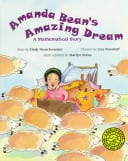Amanda Bean’s Amazing Dream: A Mathematical Story
 All Classroom Lessons
All Classroom Lessons
A Lesson for Second and Third Grade
by Cindy Neuschwander
Related Publication:
Amanda Bean’s Amazing Dream
by Cindy Neuschwander

Amanda Bean loves to count anything and everything. But sometimes she just can’t count fast enough. Her teacher tries to convince her that multiplying might help, but Amanda will have none of it—until she has an amazing dream about free-wheeling sheep on bicycles, speed-knitting grandmas, and who knows how many long-sleeved sweaters. Only then does Amanda realize that she can count on multiplication.
In Amanda Bean’s Amazing Dream, Cindy Neuschwander makes a convincing case to children about why they should learn to multiply. The story helps children see what multiplication is, how it relates to the world around them, and how learning to multiply can help them. The story is enhanced by Liza Woodruff’s zany and imaginative illustrations.
At the end of the story, the section titled “For Parents, Teachers, and Other Adults,” which is part of all Brainy Day Books, explains what’s important for children to learn about multiplication and suggests three activities to extend children’s learning. The first activity explains how to use the illustrations in the book to help children think about multiplication. The second activity is “Things That Come in Groups,” is taken from the Math By All Means multiplication unit. The third activity, “Which Has More?,” suggests multiplication riddles for children to solve. Children love riddles, and these are designed to have them use multiplication to compare quantities. Here are three samples that relate to Amanda Bean’s Amazing Dream:
- Which has more wheels—5 tricycles or 7 bicycles?
- Which has more cookies—3 rows with 8 cookies in each row or 4 rows with 6 cookies in each row?
- Which has more panes—a window with 5 rows and 4 panes in each row or a window with 3 rows and 6 panes in each row?
After your students solve these riddles, have them work together to make up others. Encourage them to look around the classroom for ideas or think of situations from their own lives.
Then have children present the riddles they wrote for their classmates to solve. You might also compile the children’s riddles into a multiplication riddle book and duplicate copies so that each child can take one home to share with their families. The children will enjoy sharing the riddles. Also, sending the book home is an effective way to communicate with parents about the kinds of math thinking their children are doing in class.

Comments